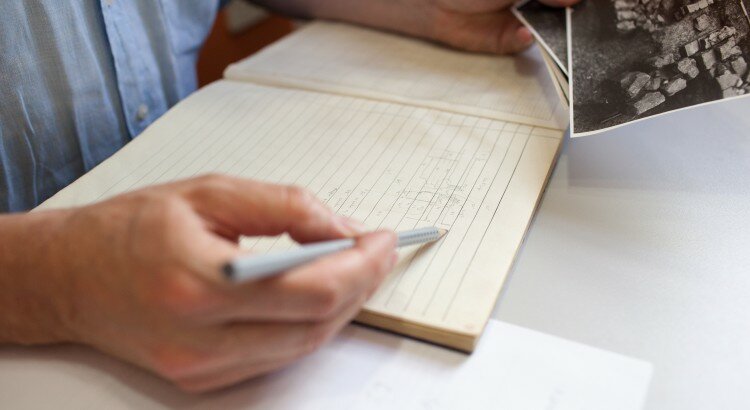Sir Ian Archibald Richmond, CBE, FBA, FSA (10 May 1902 – 5 October 1965) was a British archaeologist and academic. He was Professor of the Archaeology of the Roman Empire at the University of Oxford, Director of the British School at Rome from 1930 to 1932, President of the Society for the Promotion of Roman Studies from 1958 to 1961, and Director of the Society of Antiquaries of London from 1959 to 1964.
Sir Ian Richmond was Lancashire born and visited Lancaster a number of times. He excavated and made notes on the Beyond the Castle site. Sadly Sir Ian Richmond suffered heart problems and was unable to finish his write up for Lancaster at the time of his death in 1965.
Whilst at the Sackler Library in Oxford, Jason and I, through the wonders of modern technology, we were able to scan and photograph parts of the notebooks relating to Lancaster.
All of the notebooks are handwritten by Sir Ian Richmond, there are some typed letters of correspondence, maps and drawings. We have a lot of information to interpret and we hope that you would like to help! We will be using an online service, issuu, to get this information to you, it should be straightforward to use, but let us know if not.
Incomplete Transcript, all assistance appreciated and fully credited. Please please additions in the comments fields and we will collate together into one document:
Lancaster
Testimonia
M. Gregson, Portfolio of fragments relative to History and Antiquities topography and genealogy of the county Palatine and Duchy of Lancaster. 3rd Edin. 1896.
269-70 “The old stone figures were found in the spring of 1794, in digging the canal in the township of Ashton. The place is retired: about two or three hundred yds to the eastward if the highway leading from Lancaster to ******* and nearly one mile NE from Ashton Hall. It appeared that the spot had been sellcted for depositing **** figures; the field was in pasture at the time the canal was out, a swale* hillock rose in the lower parts of it, more *** and green than other parts of the land. Upon digging this place a considerable depth of soil was removed; the spade at length began to touch upon stones, as the workmen then used their picks; by this operation several parts of the figures were damages. The whole of **** were in the ****** of about six yards square and laid carefully in the hole about three feet deep) which had been made
